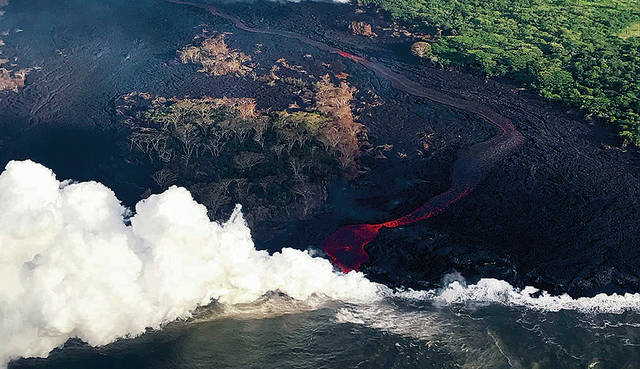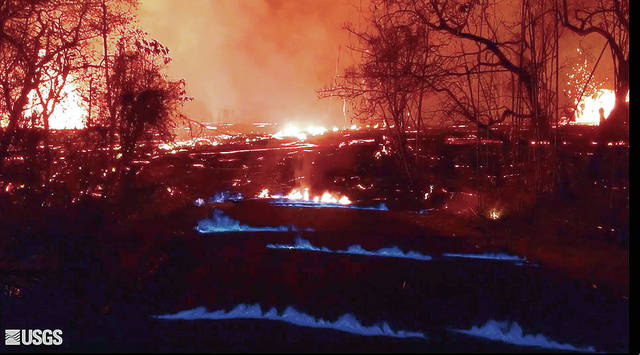Evacuation by air could have Lower Puna residents out in hours, official says

U.S. GEOLOGICAL SURVEY
Kilauea Volcano’s channelized lava flowed toward the ocean entry on Wednesday. The fissure complex is at the upper center.

GEORGE F. LEE / GLEE@STARADVERTISER.COM
Above, ash billowed from Kilauea Volcano on Wednesday.

U.S. GEOLOGICAL SURVEY
Methane gas from vegetation buried by lava burned blue as it erupted through cracks on Kahukai Street in Leilani Estates early Wednesday.



HILO >> An air evacuation of the portions of Lower Puna that are threatened by the Kilauea Volcano eruption could be accomplished within four hours if that becomes necessary because of damage to ground transportation routes, according to Hawaii Army National Guard commander Brig. Gen. Kenneth Hara.
In a briefing this morning at Hawaii County Civil Defense headquarters, Hara told state, county and federal officials that he has arranged for two Sikorsky CH-53 Sea Stallion helicopters to be available for evacuation missions now that lava from the Lower East Rift Zone has flowed to the sea and severed Highway 137 along the coast.
The movement of that river of the lava means there is only one ground evacuation route available for an estimated 1,000 residents who are still in homes scattered across thousands of acres of rural land in the Kalapana area, including Opihikao, Black Sand Beach subdivision, Kalapana Seaview Estates, Puna Beach Palisades and Kahena.
>> Evacuation by air could have Lower Puna residents out in hours, official says
>> Volcano could dent booming tourism industry
>> Puna man ‘just wanted to live’ after nearly losing leg to lava bomb
>> Geothermal plant on Hawaii island declared ‘essentially safe’
>> Leilani Estates family ‘heartbroken’ as huge crack runs under their home
RELATED PHOTOS AND VIDEO
>> Live webcams from Hawaii island
>> Photos: Lava in Leilani Estates, May 23
>> Photos: Lava approaches Puna Geothermal Venture, May 22
>> Photos: Pahoa community meeting, May 22
>> Video: Victor Hoapili talks as lava fountains erupt in his backyard
>> Video: Ken Szymanski talks about lava fissures in his neighborhood
COMPLETE KILAUEA COVERAGE
>> Star-Advertiser volcano coverage
>> Kilauea Volcano YouTube playlist
Don't miss out on what's happening!
Stay in touch with breaking news, as it happens, conveniently in your email inbox. It's FREE!
Janet Snyder, spokeswoman for Hawaii island Mayor Harry Kim, said the Sea Stallions can ferry up to 43 people out of the area at a time. One of the helicopters is already on Hawaii island, and the other is expected to arrive today, she said.
“They can basically evacuate a whole subdivision of 500 people within two hours,” Snyder said.
Hara has been appointed to head a “dual-status command Joint Task Force 5-0” in response to the eruption, an arrangement that gives him authority to command both National Guard and active military forces to carry out operations in response to the emergency in Puna.
Hara reported that he also can call on Sikorsky UH-60 Black Hawk helicopters from the 25th Combat Aviation Brigade at Wheeler Army Air Force Base on Oahu if they are needed.
The possibility of an air evacuation is emerging as a real possibility because scientists know that lava has been passing beneath Highway 130 along the East Rift Zone and surfacing in areas in and around Leilani Estates since the eruption began on May 3.
That suggests it is possible new fissures could open west of Leilani that would cut Highway 130, leaving a large area from MacKenzie State Recreation Area to Kalapana without a ground evacuation route.
Hawaii Civil Defense Agency Administrator Talmadge Magno said Tuesday the cracks in Highway 130 that closed the route for a time earlier this month have not been widening. The highway reopened after crews dropped steel plates across the cracks to provide safe access for traffic.
“Our state highways folks and our public works folks say they can try to keep it open as long as possible,” he said. “Right now, they’ve got the steel plates on it. Whether it is dumping out huge quantities of material just to fill cracks and so forth, they’ll do it.”
“We’re looking at some alternate routes, but everything’s going to have to cross that East Rift, so we’re limited on alternatives, but part of our messaging all the time has been to let these people know that this is coming down, that possibly they’re going to get isolated, so they need to make that decision,” Magno said. “If you need to be in Hilo or another place for work, you need to start considering moving out.”
The one road that could direct traffic away from the East Rift eruption area is Chain of Craters Road. State and federal officials have been planning to reopen that route, which extends from Kalapana to the Hawai‘i Volcanoes National Park, but construction has not yet begun on that project.
Chain of craters was reopened by the county as an emergency access route when another lava flow threatened Pahoa in 2014 and 2015, but lava from Kilauea once again has blocked the route. The flow that caused the latest blockage ceased last year.
Gov. David Ige told reporters Tuesday that “we are evaluating reopening Chain of Craters Road, but it’s a very dangerous road, it hasn’t been used for a long time, so we do have county and highway people really looking at it and trying to prepare it should it be necessary.”
Ige said transportation officials are “also looking at other alternative routes and trying to decide what would make the most sense in terms of providing safe passage. We do know that we need to keep roads open so that residents can get around, and we’re committed to doing that in the best and safest way that we can.”
State contractors with ground-penetrating radar were scheduled to check the condition of the road Wednesday, and thermal imaging equipment “has already revealed at least one hot spot, but we’re hoping they can work around that and get the road done,” said Jessica Ferracane, public information officer for Hawai‘i Volcanoes National Park.
Ferracane said state and federal authorities were working on a formal agreement governing the re-opening of the road, and stressed that the purpose of the road is to create “an evacuation route only.” When asked if that means residents would be able to leave but not use the road to return to their homes in Lower Puna, Ferracane said she would have to check.




